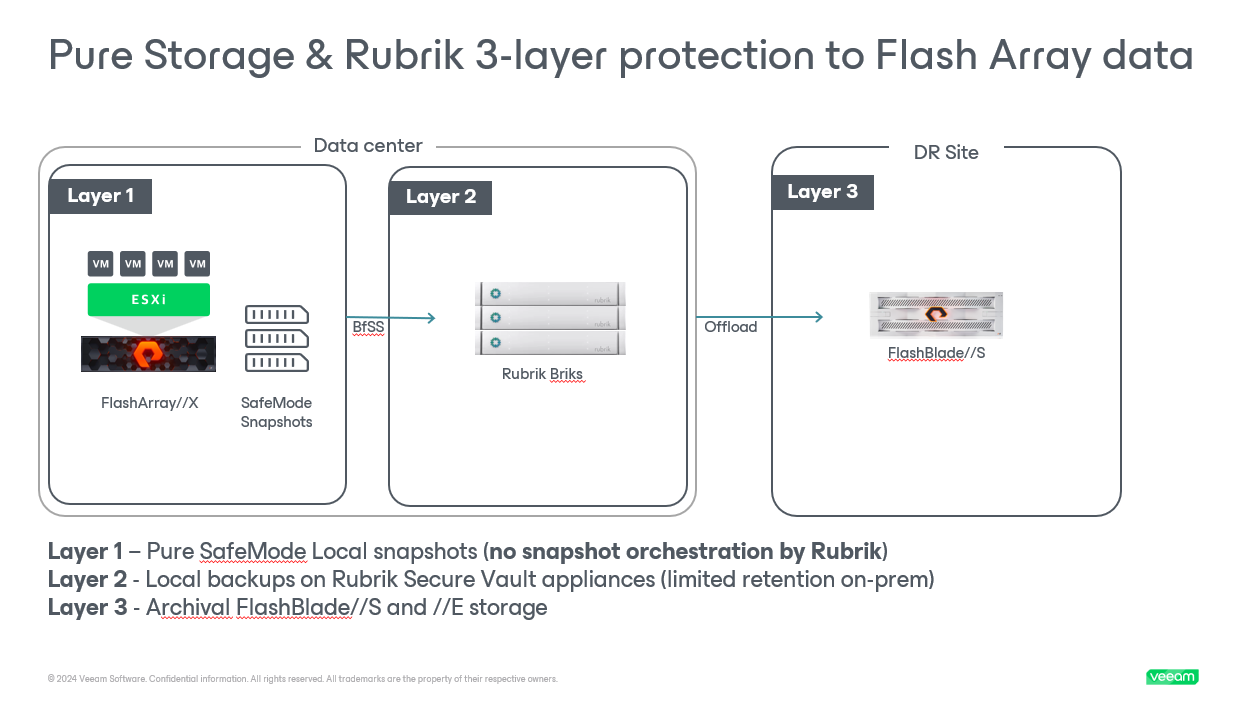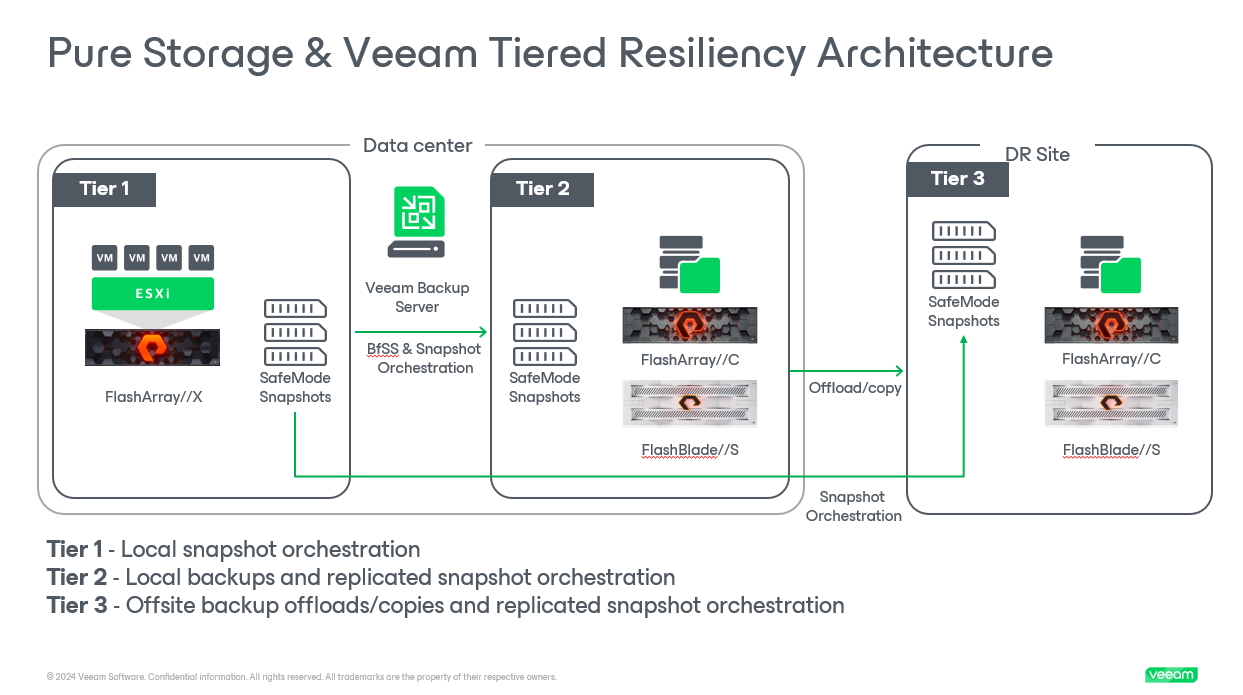On September 26, 2024, Pure Storage and Rubrik announced a partnership “to arm global customers with a proven reference architecture to ensure uptime and a path forward in the face of growing cyber threats”. And while the press releases, blogs, data sheets and even the white paper (see Resources) have all the right Cyber Resilience key buzz words, there is nothing new, or that interesting, from a product integration and solution perspective.
What was announced?
“a three-layered defense strategy” which includes:
- Layer 1 - Rapid Recovery – recovery from Pure Storage FlashArray storage snapshots, using Pure’s recovery tools
- Layer 2 - Data Security – separately, from Rubrik with their Secure Vault appliance and from Pure with FlashArray SafeMode-enabled immutable storage snapshots
- Layer 3 - Archival Location – long-term retention on Pure Storage FlashBlade object storage

How does that compare?
Pure Storage and Veeam have more valuable and deeper storage snapshot integration and solutions that provide Zero Trust Data Resilience.
Let’s dig into the differences at each “layer” of the Rubrik & Pure announcement:
Layer 1 – Rubrik can Backup from Storage Snapshot (BfSS) from Pure’s FlashArray storage. Full stop.
Veeam Backup & Replication (VBR) can do that too, plus it can:
- Orchestrate the creation and retention of snapshots on primary and secondary FlashArrays.
- Perform full, instant, and granular recovery from primary or secondary FlashArray snapshots.
- Enable On-demand Sandbox with Pure FlashArray storage snapshots for a variety of use cases including, but not limited to, malware scanning, troubleshoot problems with virtual machines, and patch/upgrade testing.
Layer 2 – Rubrik can only work with its own backups stored on its own appliances, not FlashArray snapshots, so all it can do is Rubrik recoveries from backup.
VBR can do that too, plus it can:
- Provide customers the choice of the on-prem backup target, either Pure FlashArray (block storage) or FlashBlade (object storage).
- With FlashArray, VBR not only can store both the backups and the FlashArray snapshots on the FlashArray backup target, but it can also recover from backup or storage snapshot with better RPOs and RTOs, and it can even recover production usage to the backup target/secondary FlashArray if the production FlashArray became disabled or compromised.
- Also, on-prem backups on both FlashArray and FlashBlade are not only immutable, but also indelible, so even if the bad actors can gain privileged access to the Pure arrays, they cannot destroy or delete the VBR backups.
Layer 3 – Rubrik appliances are sized to store only 30 days of retention, so they need to move longer retention to FlashBlade object storage, it can also copy the 30-day retention to FlashBlade.
Can VBR do that? That and more!
- VBR can also copy backups, and send storage snapshots, to an off-site FlashArray, so all the functionality I just mentioned that can be done with on-prem backup storage can be done with off-site backup storage.
- Additionally, VBR can orchestrate snapshot offloads, in snapshot format, to an off-site FlashBlade (or other S3 or NFS target) for long-term snapshot retention in addition to long-term backup retention.
Bottom line
In today’s world of constant cyber threats two things are critical for any cyber resilient solution: secure data, and fast and simple recovery.
Secure Data
Rubrik can only secure the data that is stored on its appliance platform. To secure the data on the production FlashArray, you must use the FlashArray UI (or APIs) because Rubrik can’t orchestrate SafeMode protected snapshots on primary or secondary FlashArrays. It also can’t orchestrate snapshot offload to FlashBlade storage.
VBR can secure backup data, plus with the integration with Pure FlashArray it enables the orchestration of SafeMode protected snapshots on primary and secondary FlashArrays, and the offload of snapshots to FlashBlade.
Fast and Simple Recovery
With Rubrik, if you want to recover data from a backup you will use the Rubrik UI. If you want to recovery data from a FlashArray storage snapshot, you will have to use the FlashArray UI. And without Rubrik being able to perform recovery from storage snapshot, the Rubrik recovery time will always involve the time it takes to move the data from the Rubrik appliances back to the FlashArray production storage. This is neither fast or simple.
VBR can perform recoveries from snapshots stored on the production, or backup storage providing the shortest possible recovery time and best possible recovery point. And VBR can do this with Veeam native recovery tools, like Veeam Explorer for Storage Snapshots or enterprise-item Explorers. No need to switch user interfaces, the backup administrator will use familiar and easy-to-use native VBR recovery tools. Fast and simple.

Resources
- Data sheet
- White paper
- Blogs – Pure blog and Rubrik blog
- Press release – Pure and Rubrik
- Purestorage.com Rubrik page
- Rubrik.com Pure Storage page





